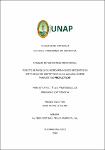Efecto de niveles de microorganismos eficientes en dieta de cuyes destetados (Cavia porcellus) sobre parámetros productivos
Abstract
This research was carried out in the guinea pig shed located within the National Autonomous University of Alto Amazonas-Yurimaguas headquarters, whose general objective was to evaluate the effect of levels of efficient microorganisms in the diet of weaned guinea pigs on productive parameters. The parameters evaluated were: food consumption, weight gain, feed conversion, mortality and economic value, using a population of 24 weaned guinea pigs of the Peru breed, using the 2x3 factorial statistical design, with three treatments and four repetitions and degree of reliability (P<0.05). They were distributed according to the following treatments: T0: 0% efficient microorganisms (ME); T1: 1.5% ME and T2: 3.0% ME. The results found of the accumulated food consumed were: T0: 1,625 kg; T1: 1,470 kg and T2: 1,632 kg, where statistical significance was observed, between the treatments under study (P > 0.05), regarding the weight increase, it was observed that there is no statistically significant difference in the study (P <0.05 ) between treatments with efficient microorganisms as reported by T0: 744.63 g; T1: 712.38 g and T2: 761.50 g. Regarding the feed conversion ratio, a statistically significant difference was found between treatments, with results of T0: 2.18; T1:2.06 and T2:2.14. No mortality problem arose during the investigation. And finally, the best economic merit was achieved with T2 (S/ 3.97), showing greater profitability. Esta investigación se ejecutó en el galpón de cuyes localizado dentro de la sede Universidad Nacional Autónoma de Alto Amazonas-Yurimaguas, cuyo objetivo general fue evaluar el efecto de niveles de microorganismos eficientes en la dieta de cuyes destetados sobre parámetros productivos. Se parámetros evaluados fueron: el consumo de alimento, incremento de peso, conversión alimenticia, la mortandad y el valor económico, utilizándose una población de 24 cuyes destetados raza Perú, empleando el diseño estadístico factorial 2x3, con tres tratamientos y cuatro repeticiones y grado de confiabilidad (P<0.05). Se distribuyeron de acuerdo a los siguientes tratamientos: T0: 0% microorganismos eficientes (ME); T1: 1,5% ME y T2: 3,0 % ME. Los resultados hallados del alimento consumido acumulado fueron: T0:1,625 kg; T1:1,470 kg y T2:1,632 kg, donde se observó significación estadística, entre los tratamientos en estudio (P > 0,05), en cuanto al incremento de peso se observaron que no existe diferencia estadística significativa estudio (P<0,05) entre tratamientos con microorganismos eficientes a lo reportado por el T0: 744,63 g; T1: 712,38 g y T2: 761,50 g. Referente al índice de conversión alimenticia, se llegó encontrar diferencia significativamente estadística, entre tratamientos, con resultados de T0: 2.18; T1:2.06 y T2:2.14. Ningún problema de mortalidad se presentó durante la investigación. Y por último el mejor mérito económico se logró con el T2 (S/ 3.97), manifestando una mayor rentabilidad.


